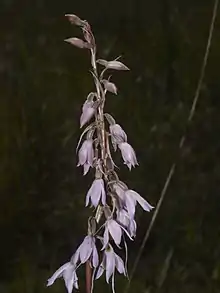| Kunai orchids | |
|---|---|
 | |
| Pachystoma pubescens in the Namdapha Tiger Reserve | |
| Scientific classification | |
| Kingdom: | Plantae |
| Clade: | Tracheophytes |
| Clade: | Angiosperms |
| Clade: | Monocots |
| Order: | Asparagales |
| Family: | Orchidaceae |
| Subfamily: | Epidendroideae |
| Tribe: | Collabieae |
| Genus: | Pachystoma Blume[1] |
| Synonyms[1] | |
| |
Pachystoma, commonly known as kunai orchids[2] or 粉口兰属 (fen kou lan shu),[3] is a genus of two species of flowering plants in the orchid family, Orchidaceae. They are deciduous, terrestrial herbs with one or two linear, pleated or veiny leaves and more or less drooping flowers which do not open widely, on a thin, wiry flowering stem. Species in this genus are found in tropical and subtropical Asia to Australia and islands of the southwest Pacific Ocean.
Description
Orchids in the genus Pachystoma are deciduous, terrestrial herbs with a branching underground rhizome and one or two linear, papery, pleated or veiny leaves. A thin, wiry flowering stem bears smallish, pink drooping flowers that are hairy on the outside. The sepals and petals are similar in size and shape, the lateral sepals having a hump at their base. The labellum has three lobes, the middle lobe projecting forwards and the side lobes unusually large.[2][3][4]
Taxonomy and naming
The genus Pachystoma was first formally described in 1825 by Carl Ludwig Blume and the description was published in Bijdragen tot de Flora van Nederlandsch Indie.[5][6] The name Pachystoma is derived from the Ancient Greek words pachys meaning "thick"[7]: 853 and stoma meaning "mouth",[7]: 754 apparently referring to a thickened callus on the labellum.[4]
Species
As of November 2022, Plants of the World Online lists the following two species of Pachystoma:[1]
- Pachystoma nutans S.C.Chen & Y.B.Luo - Myanmar[8]
- Pachystoma pubescens Blume - between tropical and subtropical Asia to the southwest Pacific[9]
In 1879, Heinrich Gustav Reichenbach described Pachystoma thomsonianum in The Gardeners' Chronicle,[10] now known as Ancistrochilus thomsonianus (Rchb.f.) Rolfe.[11] The specific epithet (thomsonianus) honours the Victorian botanist George Thomson.[12]
References
- 1 2 3 "Pachystoma". Plants of the World Online. Retrieved 15 November 2022.
- 1 2 Jones, David L. (2006). A complete guide to native orchids of Australia including the island territories. Frenchs Forest, N.S.W.: New Holland. pp. 360–361. ISBN 1877069124.
- 1 2 Chen, Xinqi; Wood, Jeffrey J. "Pachystoma". Flora of China. Retrieved 28 October 2018.
- 1 2 D.L.Jones; T.Hopley; S.M.Duffy (2010). "Pachystoma". Australian Tropical Rainforest Orchids. Centre for Australian National Biodiversity Research (CANBR), Australian Government. Retrieved 28 May 2021.
- ↑ "Pachystoma". APNI. Retrieved 28 October 2018.
- ↑ Blume, Carl Ludwig (1825). Bijdragen tot de Flora van Nederlandsch Indi. Batavia. p. 376. Retrieved 28 October 2018.
- 1 2 Brown, Roland Wilbur (1956). The Composition of Scientific Words. Washington, D.C.: Smithsonian Institution Press.
- ↑ "Pachystoma nutans". World Checklist of Selected Plant Families (WCSP). Royal Botanic Gardens, Kew.
- ↑ "Pachystoma pubescens". World Checklist of Selected Plant Families (WCSP). Royal Botanic Gardens, Kew.
- ↑ Reichenbach, Heinrich G. (1879). "New Garden Plants". The Gardeners Chronicle. 12: 582. Retrieved 15 November 2022.
- ↑ "Ancistrochilus thomsonianus". Plants of the World Online. Retrieved 15 November 2022.
- ↑ Veitch, James Herbert (1906). A History of the Rise and Progress of the Nurseries of Messrs. James Veitch and Sons, Together with an Account of the Botanical Collectors and Hybridists Employed by Them and a List of The Most Remarkable of Their Introductions. London: J. Veitch & sons. p. 147. Retrieved 15 November 2022.
External links
 Media related to Pachystoma at Wikimedia Commons
Media related to Pachystoma at Wikimedia Commons- The Internet Orchid Species Photo Encyclopedia - Pachystoma pubescens